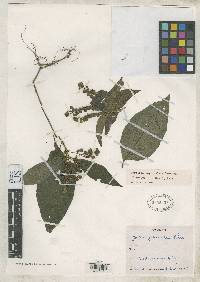
Neotropical Flora
|
Family: Acanthaceae
|
Herbs up to about 30 cm. high, erect or sparingly branched, some- imes decumbent at base, the stems subquadrangular (the angles rounded), pilose, the hairs up to 2 mm. long, these intermixed with minute retrorsely recurved hairs, both kinds of hairs more or less bifariously arranged, the lowermost portions of the stem sometimes terete and glabrate; leaf blades oblong-ovate, up to 15 cm. long and 6 cm. wide, acute to acuminate (the tip itself obtuse), narrowed from below middle to an acute base, rather thin, entire or undulate, the upper surface glabrous or sparingly hirtellous, the hairs mostly con- fined to the costa and lateral veins, up to 0.48 mm. long, appressed, the lower surface hirsute and hirtellous, the hairs confined to costa and lateral veins, more or less spreading, up to 1.5 mm. long, those of the intercostal areas up to 0.38 mm. long and appressed, the venation (lateral veins 8 to 10 pairs) scarcely prominent, the cystoliths (?) minute and subpunctiform; petioles up to 1 cm. long, pilose; flowers secund, borne in rather lax spikes up to 6 cm. long and 1 to 1.5 cm. broad, these forming terminal leafy panicles usually up to about 6 cm. broad, the spikes erect or ascending, the internodes of the inflorescence (lowermost up to 14 mm. long) and rachises bifariously and minutely strigose with additional spreading brownish hairs (up to 2 mm. long) present in more or less abundance; bracts subtending the flowers loosely imbricate, suborbicular, about 6 mm. in diameter, obtuse or rounded and apiculate at apex, unguiculate at base (the claw slender, 4 to 5 mm. long), ciliate, the hairs spreading, mostly up to 1.5 mm. long, the flat surfaces glabrous or the costa and lateral veins (usually 2 pairs) minutely and sparingly strigose; bractlets subulate, barely 0.5 mm. wide, thin, glabrous except the pilose tips; calyx 4 to 5 mm. long, deeply segmented, the segments lanceolate, 0.5 mm. wide, acuminate (the tips slender), glabrous or bearing a few scattered hairs; corolla about 14 mm. long, lilac, minutely pubescent, the tube about 1.5 mm. broad at base, 3.5 mm. broad at mouth, the upper lip erect, triangular-ovate, 3 mm. wide at base, gradually narrowed to tip, this bilobate, the lobes about 0.25 mm. long and wide, rounded, the lower lip more or less spreading, cuneate, 6 mm. wide at base of lobes, these ovate, about 4 mm. long and 2 to 3 mm. wide, rounded at tip; stamens exserted about 2 mm. beyond the mouth of the corolla tube, the anthers 1.75 mm. long, the lobes superposed, vertically attached to the connective, glabrous, the lower lobe calcarate, the tail about 0.25 mm. long, blunt; capsules clavate, 1 cm. long, 3 mm. at tip; stamens exserted about 2 mm. beyond the mouth of the corolla tube, the anthers 1.75 mm. long, the lobes superposed, vertically attached to the connective, glabrous, the lower lobe calcarate, the tail about 0.25 mm. long, blunt; capsules clavate, 1 cm. long, 3 mm. wide, 1.5 mm. thick, glabrous; retinacula 1.5 mm. long, the tip rounded, thin, shallowly cucullate, erose; seed suborbicular, about 1.5 mm. in diameter and 0.5 mm. thick, brown, tuberculate. Type in the U. S. National Herbarium, No. 2029221, collected at Villavicencio, Intendencia of Meta, Colombia, July 12, 1945, by Helen Schiefer (No. 813A). Also of this species are Helen Schiefer's No. 813 (GH) collected with the type and Cuatrecasas' No. 13198 at El Banco, at the con- fluence of the Ríos Cubugón and Cobaría, in the region of Sarare, Department of Norte de Santander, altitude 320 meters, November 15, 1941. Justicia unguiculata is easily recognized among other Colombian species by its conspicuous ungulate ciliated bracts. These are strik- ingly similar to those of Jacobinia ariologa but are much smaller. The closest relative is probably Justicia pilosa (Nees) Lindau of Perú. This it resembles in many respects, especially as to the inflorescences. The ovate leaf blades of the Peruvian species however are much smaller, the uppermost barely exceeding the spikes or even shorter, and gradually narrowed from below the middle to an obtuse tip. In size they rarely exceed 5 cm. in length and 2.5 cm. in width, whereas the thinner blades of J. unguiculata are as much as 15 cm. long and 6 cm. wide and are often slenderly acuminate. The specific epithet, unguiculata, alludes to the unguiculate or clawed bracts. |
Powered by Symbiota.



